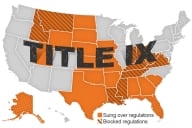You have /5 articles left.
Sign up for a free account or log in.
The facts of women being more likely than men to go to college, perform better academically, and major in fields other than science, technology, engineering and mathematics are mostly attributable to factors affecting students before – in some cases, long before – they enter the halls of academe. But that doesn’t mean colleges can’t do anything to mitigate the consequences.
Those are the conclusions of the authors of a new book, The Rise of Women (Russell Sage Foundation), about how and why female students continue to outpace their male counterparts in education (yet still can’t seem to earn a comparable paycheck).
“We’ve seen astonishing change over a very short historical period,” Thomas DiPrete, the book’s co-author and a sociology professor at Columbia University, said on a call with reporters Wednesday.
Starting with the people born around 1950, the rate of men’s bachelor’s degree completion stopped growing, and it stayed stagnant for years. In 1970, 20 percent of men and 14 percent of women finished college. By 2010, women’s graduation rates had “skyrocketed” to 36 percent, DiPrete said, while the rate among men grew only seven points, to 27 percent.
Today, women outpace men in college enrollment by a ratio of 1.4 to 1.
Beginning as early as kindergarten, the authors explained, girls have better average social and behavioral skills than boys, and that relates to girls’ higher average grades at each stage of school and why girls are more likely to earn a degree.
“The grade gap isn’t about ability,” said Claudia Buchmann, co-author and sociology professor at Ohio State University, “it’s really more about effort and engagement in school.”
On average, middle school girls are more likely to say they like school and good grades are important, and are thus more likely to study more.
“The flip side of course, is that boys’ lower engagement in school leads to weaker preparation, and then reduces their chances of getting through college,” Buchmann said.
The authors’ research found that the difference-maker for boys is schools with strong academic climates.
“We really need schools that set high expectations, that treat students as individuals – not just as gendered groups – and also motivate students to invest in their education so that they can reach the big returns of a college degree that exist in today’s labor market,” Buchmann said.
Gender stereotypes are also at play, the authors found. Boys have historically been trained to think that they needn’t obey rules or work hard because men used to be able to drop out of high school and still earn wages comparable to better-educated women, thanks to jobs in fields like manufacturing, construction and travel. That’s not the case anymore.
Even today, DiPrete said, young men are “overly optimistic” about their ability to earn a livable salary, even though they’re less educated than women. That may cause them to “under-invest” in schoolwork, lowering their academic performance and probability of completing college.
(These findings corroborate some previous research. A 2010 paper in the journal Gender Issues found that gender stereotypes and lack of information may be limiting boys’ likelihood of attending college. Judith Kleinfeld, a psychologist at the University of Alaska at Fairbanks, found that some boys did not know they’d likely need a college degree, and many believed boys are lazy or prone to peer pressure.)
One way to address the motivation issue is through better guidance counseling, DiPrete said.
“If they want to be a varsity player on a high school basketball team, they know perfectly well that they can’t tend to other interests for several years and then when they’re juniors in high school get serious about basketball and think they have any chance in the world of making the varsity team,” he said. “Given that they don’t actually have an idea of how much work they have to do in order to succeed at whatever their level of educational expectations, it’s hard for them to calibrate their effort.”
For those who do make it to college, “The biggest problem for gender inequality among the college-educated remains the lack of gender integration across fields of study,” said Philip Cohen, a professor of sociology at the University of Maryland at College Park.
Yet as the book explains, the high school years – not the college ones – are where students begin to segregate in choice of major. In those years, more women than men lose interest in science and technology fields. (In college, there’s no difference between men and women in completion rates.)
And the education system may be to blame. Women who attend high schools that greatly emphasize STEM subjects have much more interest in those majors in college, Cohen explained. “I would love to see that suggestion get more traction before we approach the idea of kids losing steam in college in America.”
Other research DiPrete is working on shows that college women are much more interested in exploring different curricular areas, which may serve to lower the odds that they’ll go into STEM and other fields that have very “lockstep” focus. Understanding the broader educational goals of women could help programs tailor their requirements so students can take a diversity of classes while also pursuing fields with heavy, set-in-stone curriculums, he said.
Although women hold almost half of all jobs in America, less than 25 percent of those positions are in STEM fields, according to the U.S. Department of commerce – and even women who study STEM fields in college are less likely to seek those jobs after graduating.
To increase attainment generally, postsecondary institutions could help by providing “clearer pathways” from college to the labor market, DiPrete said. Part of the reason that the United States has the highest drop-out rate in the industrialized world is that students often don’t know how to get jobs or the college credentials they need.
It could also help – at all levels of education – to emphasize the benefits other than economic ones of getting a college degree: better health, more democratic engagement and higher job satisfaction, to name a few.
Full-time working women in 2011 earned only 82 percent of what men earned. That’s up 20 percentage points from 30 years ago, thanks in part to women getting more education and access to high-paying managerial positions, but also an internal motivation to get a degree as “insurance” to be able to make a middle-class living.








